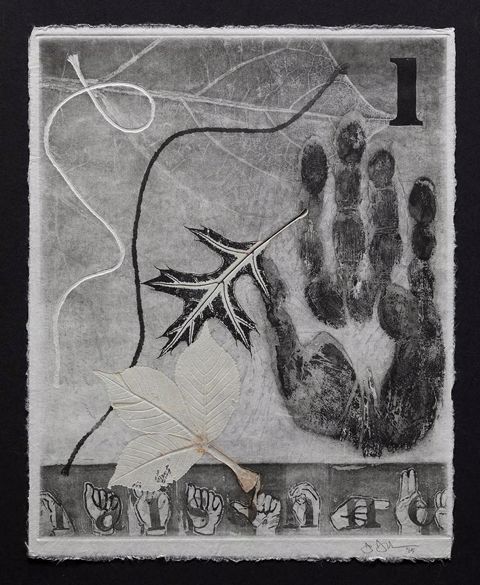One hundred unique prints by Jasper Johns at the Museum of Fine Arts, Houston, this fall

Jasper Johns, 1, Catalogue Raisonné, 2015, monoprint on hand-torn Kurotani Kozo paper, private collection. © 2019 Jasper Johns / Licensed by VAGA at Artists Rights Society (ARS), NY
Jasper Johns, Land’s End, 1979, etching and sugar-lift aquatint in nine colors on wove paper, the Museum of Fine Arts, Houston, Museum purchase funded by Robert Devlin, John Graf, Rod Martin, and AIG American General in honor of Fayez Sarofim at “One Great Night in November, 2000.” © 2019 Jasper Johns / Licensed by VAGA at Artists Rights Society (ARS), NY
Jasper Johns: 100 Variations on a Theme marks first presentation of the artist’s 2015 monoprint series, originally commissioned for his 2017 catalogue raisonné
HOUSTON—September 11, 2019—This month, the Museum of Fine Arts, Houston, will debut Jasper Johns’s series of 100 monoprints in the exhibition Jasper Johns: 100 Variations on a Theme. Originally created by the artist in 2015 with the intention of accompanying his Catalogue Raisonné of Paintings and Sculptures, published in 2017 by the Wildenstein Plattner Institute, the monoprint series will be on view in Houston September 29, 2019, through February 16, 2020 before traveling on to the Museum Barberini in Potsdam, Germany.
“This extraordinary suite of unique prints allows us to look back at the whole of Jasper Johns’s career,” commented MFAH director Gary Tinterow. “Their visual language expresses the many autobiographical details that have been so important to his identity as an artist.”
“This series provides the opportunity to see Johns’s creative process at work, as he manipulates the imagery in a playful and spontaneous manner. Each print informs the next,” said Dena M. Woodall, associate curator of prints and drawings. “We are delighted to share Johns’s monoprint series for the first time with our audience in Houston.”
Beginning in the early 1950s, Jasper Johns painted flags, targets, alphabets, and other everyday objects, creating a visual vocabulary that has recurred in his art for the nearly six decades since. At a time when abstraction was at its height, Johns’s selection of ordinary objects as his subject matter was a radical departure that quickly established him as one of America’s most influential artists. Jasper Johns: 100 Variations on a Theme exemplifies Johns’s innovation, displaying a series of 100 monoprints that incorporate elements from throughout his career.
As a prolific printmaker, Johns has worked with every technique, exploring the creative potential of each. Though printmaking is characteristically known for its ability to create a repeatable image, monotype and monoprint methods are known for their uniqueness: monotypes are typically made by applying viscous ink onto a smooth, nonabsorbent, unmarked metal or plastic plate, while monoprints use a plate with some fixed, repeatable carved, etched or engraved lines. The plate is then topped with paper and run through the press. For Johns, monotypes and monoprints are placed in the same category because of their changeability in printing. Both are unique during the printing process, leaving behind one strong impression that cannot be replicated exactly.
Johns created this series of 100 monoprints in 2015, over the course of 10 days in his Connecticut studio. The artist used an experimental intaglio plate—related to the 2007 etching titled Within—as the basis for the monoprint. Reworking the plate numerous times, Johns added an etched imprint of his hand and symbols of American Sign Language (ASL) and proceeded to transform the image 100 times. Each print informs the next, forming a narrative chain anchored by reoccurring elements from throughout his work: handprints, stenciled numbers, the alphabet, ASL symbols, and the string from his Catenary series of 2001. Johns also creatively wove the word raisonné into each print, using both letters and ASL symbols.
Other works on paper by Johns, including the artist’s Savarin (1977–81), Land’s End (1979), and Untitled (Red, Yellow, Blue) (1984), from the Museum’s collection and private collections, will be presented alongside the monoprint series to give context to the artist’s recurring themes and motifs.
About the Museum of Fine Arts, Houston
Established in 1900, the Museum of Fine Arts, Houston, is among the 10 largest art museums in the United States, with an encyclopedic collection of nearly 70,000 works dating from antiquity to the present. The Museum’s Susan and Fayez S. Sarofim main campus comprises the Audrey Jones Beck Building, designed by Rafael Moneo and opened in 2000; the Caroline Wiess Law Building, originally designed by William Ward Watkin, with extensions by Ludwig Mies van der Rohe completed in 1958 and 1974; the Lillie and Hugh Roy Cullen Sculpture Garden, designed by Isamu Noguchi and opened in 1986; the Glassell School of Art, designed by Steven Holl Architects and opened in 2018; and The Brown Foundation, Inc. Plaza, designed by Deborah Nevins & Associates and opened in 2018. Additional spaces include a repertory cinema, two libraries, public archives, and facilities for conservation and storage. Nearby, two house museums—Bayou Bend Collection and Gardens, and Rienzi—present American and European decorative arts. The MFAH is also home to the International Center for the Arts of the Americas (ICAA), a leading research institute for 20th-century Latin American and Latino art. mfah.org
Organization & Funding
This exhibition is organized by the Museum of Fine Arts, Houston.
Media Contact
Katie Jernigan, publicist
kjernigan@mfah.org | 713.639.7516
